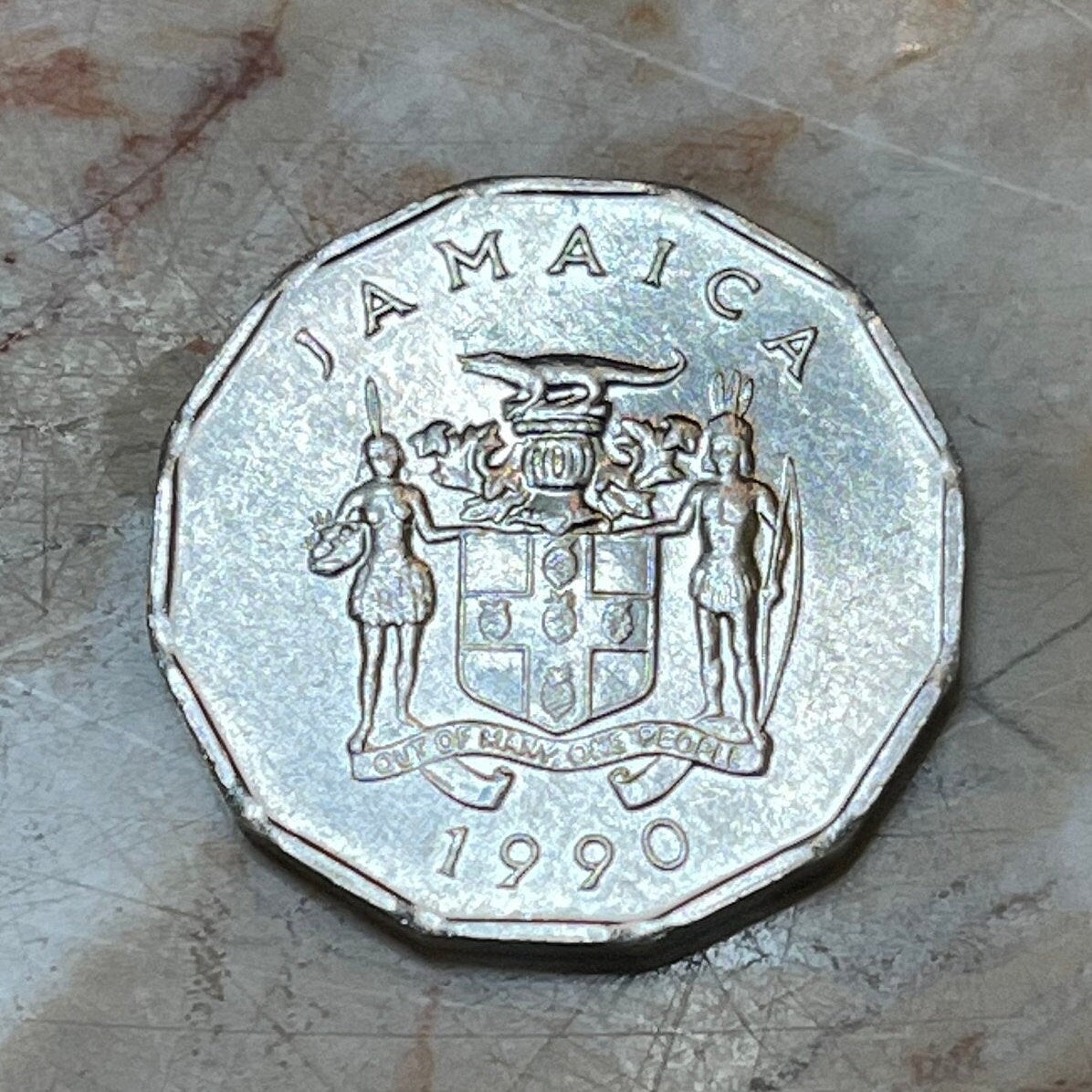elemintalshop
Ackee Fruit & "Produce Food" Jamaica 1 Cent Authentic Coin Money for Jewelry and Craft Making
Ackee Fruit & "Produce Food" Jamaica 1 Cent Authentic Coin Money for Jewelry and Craft Making
Couldn't load pickup availability
Ackee Fruit Jamaica 1 Cent Authentic Coin Charm for Jewelry and Craft Making
Obverse: Coat of Arms
Lettering: JAMAICA
OUT OF MANY, ONE PEOPLE
Reverse: Ackee fruit, flower and leaves
Lettering: LET US PRODUCE MORE FOOD
Features
Issuer Jamaica
Queen Elizabeth II (1952-date)
Type Circulating commemorative coin
Years 1975-2002
Value 1 Cent (0.01 JMD)
Currency Dollar (1969-date)
Composition Aluminium
Weight 1.22 g
Diameter 21.08 mm
Thickness 1.2 mm
Shape Dodecagonal (12-sided)
Orientation Medal alignment ↑↑
Demonetized 02-15-2018
Number N# 901
References KM# 64
Wikipedia:
The ackee, also known as ankye, achee, akee, ackee apple or ayee (Blighia sapida) is a fruit of the Sapindaceae soapberry family, as are the lychee and the longan. It is native to tropical West Africa. The scientific name honours Captain William Bligh who took the fruit from Jamaica to the Royal Botanic Gardens in Kew, England in 1793. The English common name is derived from the West African Akan akye fufo.
Although having a long-held reputation as being poisonous with potential fatalities, the fruit arils are renowned as delicious when ripe, prepared properly, and cooked, and are a feature of various Caribbean cuisines. Ackee is the national fruit of Jamaica and is considered a delicacy.
Ackee is an evergreen tree that grows about 10 metres tall, with a short trunk and a dense crown. The leaves are paripinnately, compound 15–30 centimetres (5.9–11.8 in) long, with 6–10 elliptical to oblong leathery leaflets. Each leaflet is 8–12 centimetres (3.1–4.7 in) long and 5–8 centimetres (2.0–3.1 in) wide. The inflorescences are fragrant, up to 20 cm long, with unisexual flowers that bloom during warm months. Each flower has five greenish-white petals, which are fragrant.
The fruit is pear-shaped and has 3 lobes (2 - 4 lobes are common). When it ripens, it turns from green to a bright red to yellow-orange, and splits open to reveal three large, shiny black seeds, each partly surrounded by soft, creamy or spongy, white to yellow flesh — the aril having a nut-like flavor and texture of scrambled eggs. The fruit typically weighs 100–200 grams (3.5–7.1 oz). The tree can produce fruit throughout the year, although January–March and October–November are typically periods of fruit production.
Imported to Jamaica from West Africa before 1773, the use of ackee in Jamaican cuisine is prominent. Ackee is the national fruit of Jamaica, and ackee and saltfish is considered by many to be the unofficial national dish.
The ackee is allowed to open fully before picking in order to eliminate toxicity. When it has "yawned" or "smiled", the seeds are discarded and the fresh, firm arils are parboiled in salted water or milk, and may be fried in butter to create a delicious dish. In Caribbean cooking, they may be cooked with codfish and vegetables, or may be added to stew, curry, soup or rice with seasonings.
The fruit has varied uses in West Africa and in rural areas of the Caribbean Islands, including use of its "soap" properties as a laundering agent or fish poison. The fragrant flowers may be used as decoration or cologne, and the durable heartwood used for construction, pilings, oars, paddles and casks. In African traditional medicine, the ripe arils, leaves or bark were used to treat minor ailments.
***********
Wikipedia:
The National Library of Jamaica describes the coat of arms as follows:
For Arms, Argent on a Cross Gules five pine-apples slipped OR: and upon a representation of Our Royal Helmet mantled OR doubled Ermine, for the Crest, On a Wreath Argent and Gules, Upon a Log fesse wise a Crocodile Proper: And for the Supporters, On the dexter side a West Indian Native Woman holding in the exterior hand a Basket of Fruits and on the sinister side a West Indian Native Man supporting by the exterior hand a Bow all proper.
Symbolism
The motto of the seal has been a matter of discussion for years since inception. The original motto, INDUS UTERQUE SERVIET UNI is the Latin translation for "The two Indians will serve as one", or rather "Both Indies will serve Together", in reference to the collective servitude of the Taino and Arawak Indians to the colonisers. The motto was replaced in 1962 with the English motto "Out of Many, One People", as tribute to the unity of the different cultural minorities inhabiting the nation. Perhaps as coincidence, the motto has the same meaning as the motto of the United States, E Pluribus Unum.
Share










5 stars review from Bear









